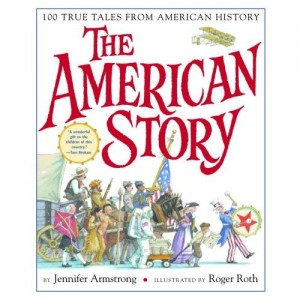
Things That We’ve Enjoyed About This Book:
- Engaging Stories – My kids are all interested each time we read a new story from The American Story. Some of the stories are funny and some are very serious, but we have found each one that we’ve read to be very interesting.
- Stories You Don’t Find in History Books – Perhaps it’s because I’m generally a fan of what others might consider superfluous information, but I really like that The American Story has stories about things that you wouldn’t find in your typical history book. There is a story how the city of Washington D.C. was laid out, a story behind the famous unfinished portrait of George Washington we all know so well, how bananas came in to popularity in the United States, the 1835 discovery of life on the Moon (which was actually when tabloid newspapers really caught on), the cookie cutter houses of post World War II, tales of the Pac-Man craze, and so many others.
- Great Illustrations – The illustrations were all done by Roger Roth. He did a great job of making illustrations appropriate to the situation, as some stories are funny and others are quite serious.
- Large Time Span – Stories in the book range from 1565 through 2000.
What Doesn’t Work as Well for Our Family:
- All Stories Have to be Previewed by Me – This is, of course, a good practice for any homeschooling material. However, it is definitely a must with this book. There are several stories that people might object to for a variety of reasons. I have still found, however, that because I like this book so much, I don’t mind having to preview stories before sharing them with the children. We have only had to skip a couple of stories thus far. One was just because I didn’t like the tone of the story, and another because I didn’t like the way that missionaries from our religious denomination were depicted. (That being said, there are other mentions of that nature in the book that we read anyway and it was an interesting opportunity for dialogue with my kids.)
- It is Not a History Textbook – It’s not fair to hold that against this book, as that is not its purpose. However, I just say it to point out that it might not be a good choice for your history spine, unless you will be doing a lot of supplementing. For instance, Henry David Thoreau made the book, but the Gettysburg Address did not.
Details About the Book
- Reading Level: Ages 9 – 12 (we have used it with younger children as a read aloud, however)
- Length: 368 pages (and it’s hard cover, so it is not a light book)
- Price: The list price on this book is $34.95 and it is from Random House. It can be found, however, from sites like Amazon for only $23.07.
Overall, I would definitely recommend this book, as long as you are willing to always be reading a little ahead of your children. However, even if something was read that you don’t agree with, I think it offers up a great opportunity for dialogue about why your family might not agree with a story (or just an aspect of a story).
Angie can be found writing at Many Little Blessings about faith, family, and household management topics. Angie is also the founder of The Homeschool Classroom and Catholic Mothers Online.

I have this book and was interested in using along with my catholic curriculum for 4th grade student. Could you share with me which stories you have opted to not read with your children?
Much appreciated. Homeschooling mother of 5,
Jeannie
Sorry – it was almost five years ago that we used it, so I don’t recall which ones were problematic. As long as you read them ahead of time, you’ll be able to tell which ones are okay and which are not.